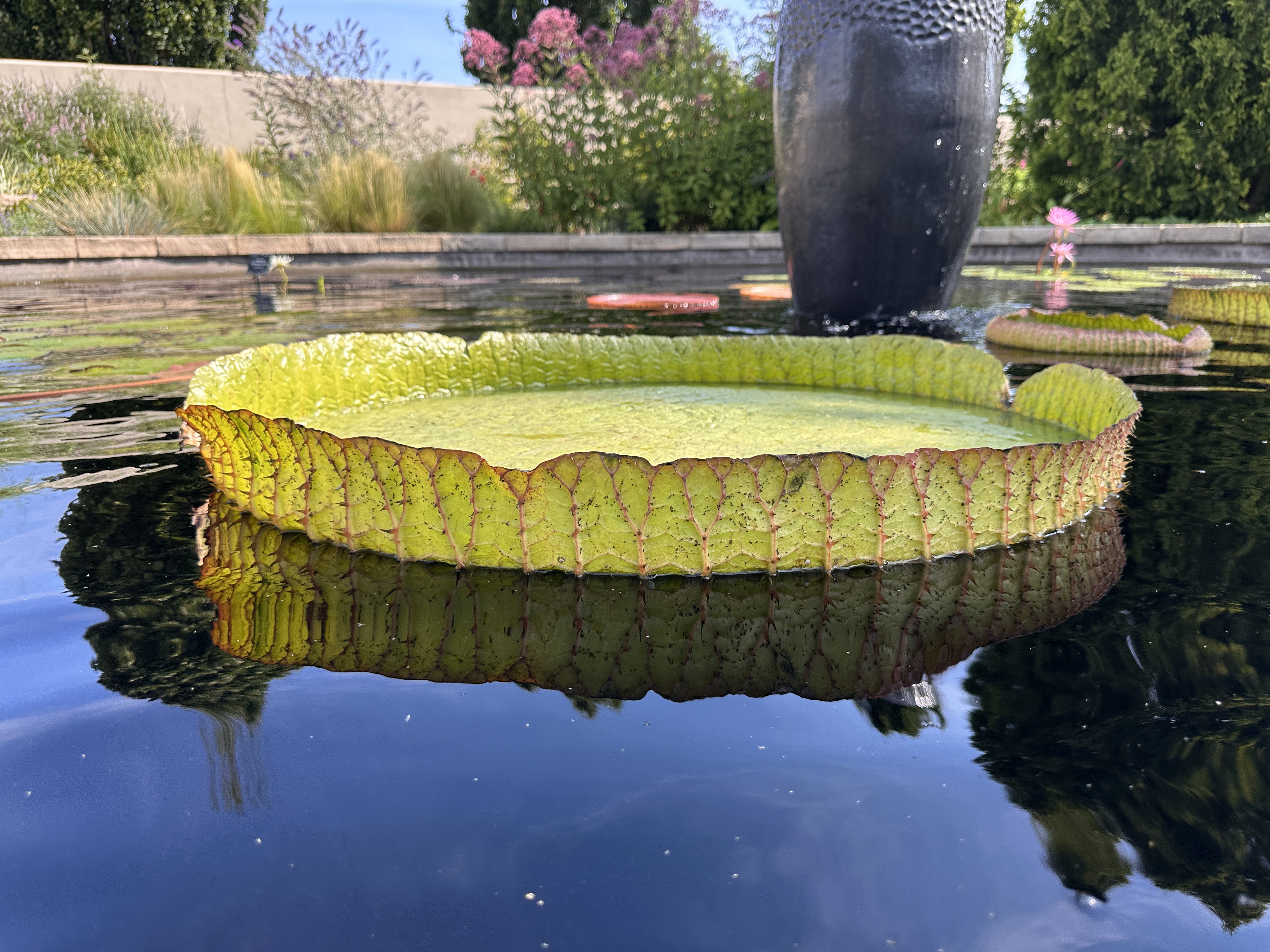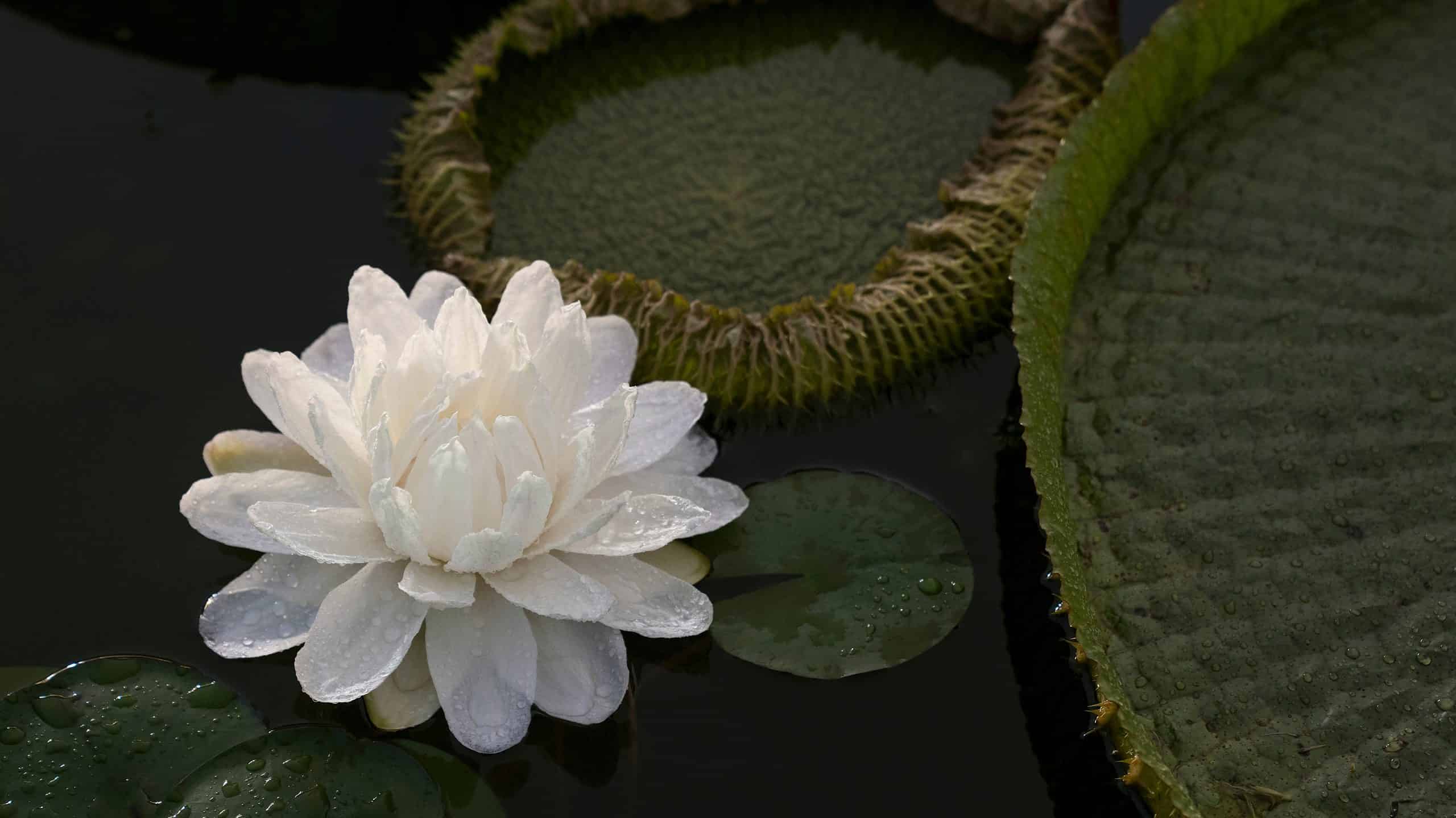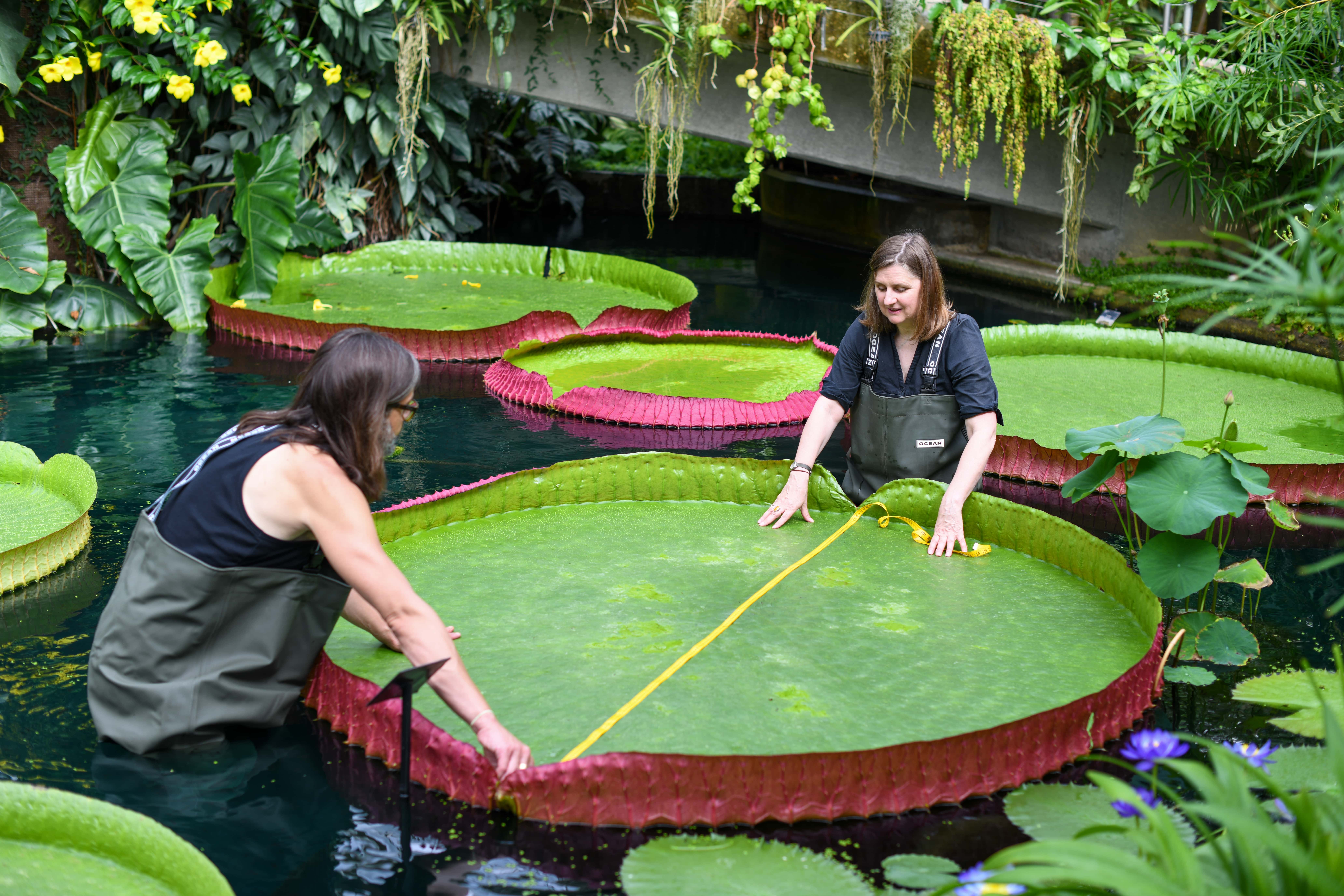Science
Related: About this forumHow Much Can a Giant Waterlily Hold? See One Carry 183 Pounds Before Sinking, Winning a Social Media Contest
Now in its third year, the Waterlily Weigh-Off invites public gardens and zoos to show off the strength of their aquatic plants
Sarah Kuta - Daily Correspondent
August 29, 2025

The pads, also known as platters, of giant waterlillies can be up to ten feet in diameter. Denver Botanic Gardens
Giant waterlilies are known for their gorgeous white or pink flowers and green leaves, which float serenely atop the surface of lakes and streams.
At first glance, these aquatic plants might seem delicate. But in reality, they’re incredibly strong. Earlier this month, the leaf of a giant waterlily at Florida’s Bok Tower Gardens supported 183 pounds before it started sinking, beating out other global competitors to be crowned champion of the 2025 Waterlily Weigh-Off.
The weigh-off, which is now in its third year, is an annual social media contest organized by Denver Botanic Gardens. To enter the competition, horticulturists at public gardens and zoos across the globe film themselves stacking weighted objects atop one of their giant waterlily pads (or smaller lilies), noting the total weight the leaf was able to hold before dipping beneath the surface.
According to Denver Botanic Gardens, the contest is a “playful opportunity” to educate the public about aquatic plants, specifically Victoria amazonica, Victoria cruziana and a mash-up of those two giant waterlily species called the Victoria ‘Longwood Hybrid.’ The leaves—also known as platters or pads—of these species can measure up to ten feet across.
The pads can hold such an impressive amount of weight because of their structure. The bottom of each leaf consists of a “highly engineered network of radiating ribs and cross-veins,” per Denver Botanic Gardens. The ribs and veins form stiff compartments that trap pockets of air, which helps distribute weight across the leaf. The tops of the pads also have upturned edges, offering a barrier that can prevent water from spreading across the surface as the leaf gets weighed down.
More:
https://www.smithsonianmag.com/smart-news/how-much-can-a-giant-waterlily-hold-see-one-carry-183-pounds-before-sinking-winning-a-social-media-contest-180987268






Judi Lynn
(164,037 posts)Paulo Cabrita
Updated:Aug 29, 2013

Amazon water lily on its natural habitat.

Detail on water lily flower and leaves.
The Amazon Giant
The main problem that aquatics plants face is light, better its absence. As you know plants need light to photosynthesize and produce their own food supply. In still waters the best way for an aquatic plant to capture light is to produce big floating leaves, and no plant does it better than the giant Amazon water lily, Victoria amazonica. While popping up at the water surface the water lily leaf starts as a large round and chubby button covered with thorns. Not so many hours after it first emerges the button opens and starts to expand rapidly. The leaf edges are curled up to 15 cm high allowing the leaf to push away any neighbouring floating leaf that gets in the way as they roll and expand. Hence, the leave not only grows in size but also gets maximum exposure to light being the sole occupier of such coveted spot. Underneath, the water lily leaf is supported by strong veins and leaf nerves that function has beams giving support and resistance. Also, those leaf nerves and the leaf petiole have numerous air channels forming a continuous pipe system throughout the whole plant body that not only helps leaf fluctuation but also it serves as the main supplier of oxygen to the roots buried in the mud bellow. The Amazon water lily leaves expand at a rate of 0.2 m2 per day reaching as much as 2.5 m in diameter and supporting up to 40 kg well distributed on their surface. The purple lower surface of the leaf, abaxial side, bellow the water, is covered with long and sharp thorns to keep fish or other animals that might eat them away. A single Amazon water lily can produce as much as 40 to 50 leaves in a single growing season. So it is not hard to imagine the area that a single Amazon water lily can occupy. In fact the Amazon water lily is so effective in its strategy that it monopolizes that space totally so that there are not many plants from other species that in fact can compete with it, and none grows near or underneath an Amazon water lily usually.
A Source of Inspiration
The first specimen of Amazon water lily collected, in British Guyana, today’s Guyana, and brought to Europe was taken by Sir Robert Schomburgk to London in 1837. Unfortunately it did not survive the trip but its remains were preserved and were sufficient to amaze and cause big fuss at the time. In fact its admiration was such that a genus was created specifically and named Victoria after Queen Victoria. The species was firstly named Victoria regia but it was then superseded. As the name suggests the Amazon waterl lily, Victoria amazonica is native to the shallow waters of the Amazon River basin. The first viable seeds arrived at Kew Gardens ten years after, in 1847. Some of the small seedlings were then sent to Joseph Paxton, gardener and main responsible for the splendid gardens of the Duke of Devonshire at Chatsworth. Paxton build a special building with a lake in it where water was maintained at a temperature similar to river Amazon. The plant grew developing its famous enormous leaves and it bloomed, for the first time outside its native Amazon forest in 1849, to the astonishment of everybody. It did not take long for the Amazon water lily to become subject of rivalry between Victorian gardeners in England. Besides being a very competent gardener Paxton was also a skilled and ingenious architect. He built one of the first big green houses. When he planned the big cast iron beams for the glass building, unprecedented at the time, he remembered the strong nerves and veins that supported the gigantic leaves of the Amazon water lily "like transverse girders and supports". Paxton used them as inspiration to its project, not only for the green house in Chatsworth but also, some years later, to his masterpiece, the London’s Crystal Palace,a building four times the size of St. Peter's in Rome. Paxton was also the main responsible for the common habit that some curious people still have today when they see the Amazon water lily. In order to impress others and to show the strength of the Amazon water lily leaves, Paxton convinced his younger daughter Annie to pose to some pictures sitting on a water lily leave.
More Than Just Size
The ability for Amazon water lily to produce such enormous structures like its leaves and flowers rests on its roots that are able to absorb nutrients from the mud bellow. However, roots need oxygen which is not abundant in river beds and lakes in the Amazon forest. To overcome this and thus supply oxygen to all its cells the leaves and petioles of the water lily have air channels forming a continuous pipe system throughout the whole plant body linking roots and leaves. The petioles can grow as much as 10 m in length. The Amazon water lily flower is as impressive as its leaves. It can grow up to 50 cm in diameter. It opens for the first time at night. It first starts by being immaculately white which makes it more visible than other flowers under low light conditions. The flower also emanates a distinct perfume irresistible to a specific species of beetles, Cyclocephala casteneaea, that gather around the Amazon water lily flowers in great number. In its centre the flower has rich nectaries that compensate the hungry beetles for the task ahead. While the beetles feast on its precious nectar the petals around them start to close slowly and eventually close all together keeping the beetles trapped for the night. As the beetles are busy feasting on its nectar the anthers (the male part of the flower) of the Amazon water lily mature a release their pollen over the beetle crowd. The flower keeps the beetle trapped until the next evening and on the second night it opens again with a totally different colour. It changed from immaculate white to pink. The beetles covered with sticky and juicy nectar and pollen all over are then released and free to feast on another flower. Evidently nearby flowers must all come from the same plant. Had the beetles landed on one of those neighbouring flowers the plant would have self pollinated making all that work wortless. However, the beetles are attracted by white flowers only and do not look for pink flowers. So, if all flowers of one plant turned pink that night no beetles that have feasted in their nectar will look for them again soon and self pollination is thus avoided. Also, those pink flowers soon die and the plant will grow new white flowers on the next day ready to be pollinated or to help pollinate other specimens by attracting another crowd of hungry beetles. The Amazon water lily only reproduces through seeds, which can lay dormant in the mud for up to 4 years before germinating. The plant goes through an annual dormancy period before producing more leaves that increase in size before flowering again.
. . .
More:
https://discover.hubpages.com/education/Amazon-Water-Lily
Wicked Blue
(8,396 posts)I love water lilies, and I've seen these giant ones at Kew and at Longwood Gardens. But I didn't know about the fascinating life cycle of the flowers, the beetles, or the amazing structure of the leaves.
![]()
electric_blue68
(25,229 posts)They're very impressive!
And, yeah the flower/beetle cycle is interesting.
I like the contest of how much weight a leaf hold.
Love water lillies of any size. So many pretty colors.